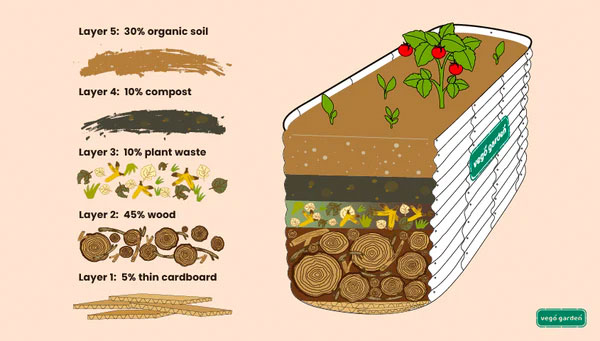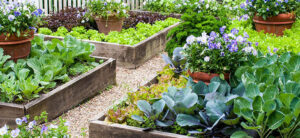
Think you don’t have the time or space to learn how to plant a raised garden bed? Think again. It’s actually much easier than you think, and takes less time to get your garden growing!
In fact, planting a raised garden bed is a great way to save yourself some time by maximizing your efficiency and making the most of the space you have.
With raised bed gardening kit, you don’t need to have perfect soil or acres of land. All you need is a bit of creativity.
Growing in a raised garden bed is a quick pathway toward growing some of your favorite plants and enjoying a fruitful harvest. If you are looking for tips on how to plant a raised garden bed, you’ve come to the right place.
What Is A Raised Garden Bed?
Curious about what a raised garden bed actually is? This phrase can refer to many different kinds of planting arrangements. However, in most cases, a raised bed is just one that sits atop the existing soil.
It can be just a few inches tall or it can be taller than your waist. It can be made out of many different materials.
Most raised beds have some sort of frame, made out of materials like wood, plastic, stone, brick, cinder blocks, patio pavers, or broken concrete.
There are all kinds of options for you to choose from! However, the common denominator here is that you will usually have some room around the outside so you can maneuver around your plants with ease without having to walk inside the bed.
Why Grow In A Raised Garden Bed?

There are benefits abound when it comes to learning how to plant a raised garden bed. For one, you'll be able to garden anywhere.
Not only can a raised garden bed be constructed atop an otherwise unusable plot of land (such as one with poor soil or even no soil at all), but it can be constructed and designed to match your existing landscape.
You can use a raised bed to cover up an eyesore, to add color to an entryway, or even to create a lovely and functional perimeter garden.
Plus, with a raised garden bed, you can make the most of limited space. You can grow plants much closer together than you might be able to in the ground so that every inch of the bed is productive.
Because the bed is elevated, you’ll find that you can plant earlier in the winter with less risk of frost. And, you’ll experience fewer water problems and cold soil to worry about in the spring.
Raised Beds Provide A Better Experience For You & Your Plants
Raised garden beds offer environments that are far superior to a regular garden.
It will be easier for you to amend the soil without having to worry about it running off and being eroded, and you’ll also have fewer weeds to worry about. The same goes for pests and diseases!

Raised Garden Bed vs Traditional Container Growing
Trying to decide whether a container garden or raised bed garden is right for you? The main drawback of a raised bed in this sense is that you will need to bend more to tend to your gardens.
Raised beds are usually positioned closer to the ground, while container gardens can be moved around to more convenient locations. They also offer fewer weeds and require less soil at planting time than raised beds.
However, the most obvious benefit of a raised bed when compared to a container garden is that of space and volume.
You’ll be able to grow many more plants in a raised bed than you could in a container garden, helping you really maximize your planting success!
How To Build a Raised Garden Bed: DIY Guide
There are two ways to grow in a raised garden bed. You can either purchase one or build your own!
You just have to decide whether you want to spend a weekend working with your hands and save a bit of cash, or save a ton of time and just purchase a raised garden bed.
We’ll start by explaining how to build a raised garden bed, for our DIY gardeners out there!
Choose Your Bed Type

Before you can start learning how to plant a raised garden bed, you need to actually build it. And that starts with deciding what type you want to build. Of course, you always buy a premade raised bed - which we will tell you more about below.
How Deep Should a Raised Garden Bed Be?
Most raised beds are at least 6” tall. The taller, the better in most cases, since the more soil depth that's available, the better the roots of the plant can grow. And the bigger the root systems, the bigger the fruit.
It will also hold more water. If you have to build your raised bed on poor soil or soil that is heavily compacted, you will want to go even taller.
Using a deeper raised bed depth will help create deep root systems, and prevent any need to do double digging to increase depth. However, not all shallow roots are bad, many popular veggies grow perfectly in raised beds with their shallow root systems.
You can choose raised beds out of all kinds of materials. Some of these include cedar, manufactured or composite wood, recycled plastic, and galvanized steel. There are even raised beds you can make out of “upcycled” materials like old tires!
How Many Feet Wide Should a Raised Garden Bed Be?
Most garden beds won't be too wide for one simple reason. If they are too wide, you won't be able to reach over to tend to your plants.
A rectangle rot-resistant bed no wider than 36 inches to 48 inches is more than wide enough to get to plants from either side.
Find the Right Location To Plant A Raised Garden Bed

Next, you’ll need to consider the best location for your raised bed. You won’t be able to move your bed after you've filled it with soil, so give some serious thought to this decision.
Ideally, you’ll want to choose a spot that will provide your plants with at least eight hours of sunlight every day.
The more sun, the better, as there are very few plants that are truly shade-loving. You will also want to avoid positioning your raised bed in a spot where the soil might stay overly soggy.
Although raised beds innately offer better drainage than gardens positioned directly in the ground, you still need to mind the slope and drainage of the area where you plan to put your raised bed.
Fill With Soil

Next, you’ll need to fill your raised bed with soil. This is, without a doubt, one of the most cumbersome aspects of building a raised bed garden.
Although the benefit of raised beds is that you can use a blend of soil that’s better than the soil found naturally on your property, it can be expensive to purchase many bags of soil from the garden supply store!
A good way to remedy this is to purchase soil in bulk, buying by the yard if you have lots of beds to fill. You can also use compost or other organic amendments to fill your beds.
Before erecting your raised beds in their permanent location and before adding soil, be sure to remove any grass or perennial weeds.
Decide What (and When) to Plant

You can plant just about any kind of vegetable, fruit, or flower in a raised bed! If you’re new to gardening, we recommend starting with easy-to-grow crops like tomatoes, lettuce greens, and cucumbers.
You could even throw a few herbs in there as you are getting started. While you should try to maximize your productivity to the greatest extent possible in your raised bed, resist the urge to overpack the beds with plants.
Start with just a few to make sure you can adhere to the spacing recommendations for each kind of plant you are growing.
Not sure when to plant? This can vary, depending on your plant type, but in most cases, you’ll want to wait until the danger of frost has passed in the spring (although there are several kinds of plants, like broccoli and carrots, that are cool-weather vegetables that can easily tolerate a frost).
Make sure you know what zone you are gardening in before you decide what kinds of plants to grow - and when to plant them. Most plants do best with moderate soil temperatures of 60 to 70 degrees Fahrenheit or so.
Tend To The Garden

After you’ve planted, it’s just a matter of tending to your crops. The beauty of vegetable gardening in a raised bed is that it will dramatically reduce the amount of garden care required to grow a healthy garden. Keep weeds to a minimum by mulching, weeding by hand, or hoeing between rows.
The more often you can remove weeds, the better - this will reduce the likelihood of weeds setting strong roots and becoming a more permanent problem for you. Fortunately, the soil in a raised bed won’t dry out as frequently as it does in a regular garden.
That means you can reduce your watering chores, although you’ll still need to water at least once per week in hot weather (potentially more often than that, too, depending on what you’re growing and what the weather is like where you live).
You may find that it makes sense to set up automatic sprinklers to make your life a little easier! If you’re new to vegetable gardening in general, check out our article on how to properly water plants.
Besides weeding and watering, your raised bed garden will only need a bit of fertilizing. You can use liquid nutrients or dry amendments. Check out our complete guide on plant nutrients & pH to learn more about this crucial aspect of growing.
How Deep Should A Raised Garden Bed Be?
Raised bed gardens can be as deep as you’d like, but remember that the deeper they are, the more resistant to weeds they will be.
They will also be easier to tend to the further they are off the ground. A bed that is 12 to 18 inches deep will be perfect for most gardeners.
How Do You Fill A Raised Garden Bed Cheaply?

There are many techniques you can use to fill a raised garden bed without spending a ton of money.
One way is to supplement your use of store-bought soil with a bit of compost that you make yourself at home.
This will not only save you money but it can also provide a beneficial dose of nutrients to your plants.
You may also want to try the hugelkultur method as it pertains to filling a raised garden bed. This involves buying large amounts of organic matter (usually rotting debris like sticks, rotten logs, and other debris) at the bottom of the bed.
It will create a sponge that will not only hard water well but will also supply your plants with nutrients. Since you’re using rotting wood, there’s no need to spend a ton of money on extra soil.
Buy A Raised Garden Bed Kit To Save Time & Energy
While you can always build a raised bed if you’re the crafty type, this method is certainly not for everyone.
In fact, you may find that you save time, energy, and even money by purchasing a prefabricated raised garden bed kit instead - particularly if you don’t have any carpentry skills.
You don’t have to have a ton of space in order to install one of these premade raised garden beds, either.
Vego Garden Raised Beds - Now Available!
At Vego Garden, the goal is to redefine raised garden beds. The company was founded with the goal of launching a modular metal garden bed system with a 20+ year life expectancy, utilizing eco-friendly metal materials instead of cutting down trees.
They emphasize innovative design and high-quality materials in all of our products. Vego Garden gained great popularity right after launching and is now the leading brand in raised garden beds.
Individual Panels To Uniquely Customize Your Garden Space
From garden beds to extension kits, and even modular trellises, Vego Garden has everything customers need to customize their own unique garden space.
Because of their commitment to affordable pricing and longevity, Vego Garden is the most cost-efficient place to build DIY garden beds. At only $0.4/ft per year in (compared to wooden beds that cost at least $3/ft per year) choosing Vego Garden makes dollars and sense.
GeoPot GeoPlanter Fabric Raised Bed
The GeoPlanter is a breathable fabric raised bed planter that helps growers achieve the ideal root environment for improved water and nutrient uptake, vigorous plant growth, and increased yields.
The high-quality geotextile fabric air-prunes the plants’ roots when they reach the end of the container, forcing them to branch out with more fibrous feeder roots, which are much more efficient in taking up water and nutrients, leading to improved yields.
How To Actually Grow in a Raised Garden Bed
Before you plant, take the time to note the instructions on your planting packet or tag carefully. That way, you’ll have an idea of what conditions your plants need to do their best.
Make sure you provide plenty of space for each plant, but don’t be afraid of planting intensively. This is the main benefit of growing in raised garden beds rather than a container garden.
You can squeeze a lot more plants into a raised bed than you can a container garden - take advantage of this!
With a raised bed, you can also install trellis cross supports to make your life easier and to support the health of your plants.
For instance, you can use row covers or cloches to protect your plants from frost, and you can install sprinklers so that you never have to water your plants by hand again. It’s also easier to erect stakes and other supports that will support your plants as they grow.
Final Thoughts on Raised Garden Beds
Now that you know how to plant or build a DIY raised garden bed, it's a matter of grabbing the tools and supplies you need to set yours up.
Growing in one is the smart way to maximize the amount of space you have available to grow. You don’t need to have a ton of know-how or experience - you just need to get creative and give raised bed kit gardening a try!











































